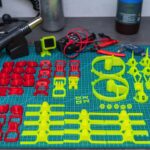I. Introduction to PET Filament Extrusion: Benefits and Budget Considerations
II. Essential Components and Tools for Building Your Own Extruder
III. Step-by-Step Guide to Assembling Your PET Filament Extruder
Introduction to PET Filament Extrusion: Benefits and Budget Considerations
Hey there! If you’re delving into the world of 3D printing, you might have come across the term “PET filament extrusion.” You might be wondering, “What’s that all about?” Well, let’s break it down together!
What is PET Filament?
PET, or polyethylene terephthalate, is a popular thermoplastic polymer that’s widely used in various applications, including the creation of 3D printing filament. It’s known for its strength, durability, and resistance to moisture, making it an excellent choice for many projects.
Why Choose PET Filament Extrusion?
Now, you might be asking yourself, “Why should I consider making my own PET filament?” Allow me to highlight some of the fantastic benefits:
- Cost-Effective: One of the most attractive benefits of producing your own PET filament is the potential for savings. Bulk purchasing of raw materials can significantly lower your costs compared to buying pre-made filament.
- Customization: When you extrude your own filament, you have the power to customize. You can tweak the color, diameter, and even add unique properties to suit your specific printing needs.
- Quality Control: By making your own filament, you can monitor the entire process, ensuring the quality meets your standards. You’ll know exactly what goes into your filament, which can lead to improved print results.
- Environmentally Friendly: PET is recyclable, and by extruding your own filament, you can use recycled PET scraps or even create filament from other recycled plastics, contributing to a more sustainable practice in your 3D printing adventures.
Budget Considerations
While the idea of building your own PET filament extruder sounds enticing, it’s essential to weigh your budget considerations carefully. Here are some factors to keep in mind:
- Initial Investment: The cost of parts and tools to build your extruder can vary significantly. It’s wise to do some research and plan your budget accordingly.
- Maintenance Costs: Like any machine, your extruder will require maintenance over time. Factor in the costs for spare parts and any necessary upgrades.
- Material Costs: While producing your own filament can save money in the long run, consider the ongoing cost of raw materials and any additives you might want to use.
- Learning Curve: There’s a learning curve involved when first starting out. You might encounter some trial and error along the way, so be patient with yourself!
Wrapping Up
So, there you have it! PET filament extrusion is not only a cost-effective solution but also opens up a world of customization and quality control. With a little planning and budgeting, you can turn this exciting project into a rewarding experience. Ready to dive deeper? Stay tuned for the next section, where we’ll explore the essential components and tools needed to build your own extruder!
Essential Components and Tools for Building Your Own Extruder
So, you’ve decided to take the plunge and build your own PET filament extruder! That’s fantastic! Getting to know what you need is a crucial first step in this exciting journey. In this guide, we’ll break down the essential components and tools you’ll need to successfully build your own PET filament extruder.
Key Components of a PET Filament Extruder
To get started, let’s look at the primary components you’ll need:
- Extruder Barrel: This is where the magic happens. The extruder barrel is the tube that melts the PET pellets. It needs to withstand high temperatures, so a quality material like stainless steel is a must.
- Screw: The screw is responsible for pushing the melted PET through the barrel. It typically has a specific design that helps with mixing and conveying the materials. You might want to consider a single-screw extruder for simplicity.
- Heaters: You’ll need several heating elements to reach the melting point of PET. These are usually placed around the extruder barrel and need to be adjustable for precise temperature control.
- Thermocouples: These are essential for monitoring the temperature inside the barrel. Accurate temperature readings are crucial to avoid overheating or underheating your material.
- Die: At the end of the extruder, the die shapes the melted PET into filament. You’ll want a die that produces the diameter of filament you’re after, typically around 1.75mm or 3mm.
- Cooling System: Once the filament exits the die, it needs to cool down quickly to maintain its shape. A simple water bath or air cooling can do the trick!
Additional Components
Besides the main components, here are a few extra parts you might want to consider:
- Feeder System: You’ll need a mechanism to feed PET pellets into the extruder. This can be as simple as a gravity-fed hopper or a more complex auger feeder.
- Filament Winder: Once you’ve extruded your filament, you’ll want to wind it onto spools for storage. A filament winder can help you achieve uniform coils.
- Control Panel: A user interface to control the heaters, monitor temperatures, and adjust the speed of the screw can make your extruder much more user-friendly. Consider integrating a PID controller for precision.
Tools You’ll Need
Now that you have a grasp on the components, let’s talk tools! Here’s a handy list to keep you organized:
- Wrenches and Screwdrivers: Essential for assembling and maintaining your extruder.
- Drill: You may need this for making holes in specific parts of your extruder.
- Multimeter: To measure electrical components and ensure everything is functioning properly.
- Safety Gear: Don’t forget gloves and goggles! Safety first, especially when working with high temperatures.
With these components and tools in hand, you’re well on your way to building your own PET filament extruder. Remember, this is a learning process, so don’t hesitate to reach out to communities or forums for additional support. Happy building!
Step-by-Step Guide to Assembling Your PET Filament Extruder
Alright, so you’re ready to dive into the exciting world of PET filament extrusion! This process can seem daunting at first, but with the right guidance, you’ll have your very own extruder up and running in no time. Let’s break it down into simple steps, shall we?
Step 1: Gather Your Components
First things first, make sure you have all your essential components. Here’s a quick checklist:
- Heating Element: This is crucial for melting the PET pellets.
- Extruder Barrel: This is where the magic happens—where the melted PET is forced through.
- Throat Adapter: Connects the feeding mechanism to the extruder barrel.
- Screw Drive: Helps push the material along the barrel and is key to achieving the right melting and mixing.
- Cooling System: Keeps the filament from melting too much as it exits the extruder.
- Spooling System: For winding your finished filament onto spools.
Cross-check these items before you start assembling to ensure you don’t find yourself halfway through without a key component!
Step 2: Assemble the Extruder Barrel
Next up is the heart of your extruder—the barrel. Begin by securely mounting the barrel to your base. This is usually done using bolts or clamps. Make sure it’s stable; you want it to stay put while you’re working with hot materials!
Once mounted, install the heating element around the barrel. Ensure it’s evenly distributed for consistent heating. You don’t want any cold spots that could ruin your filament!
Step 3: Install the Screw Drive
Now that the barrel is set, it’s time to introduce the screw drive. Carefully insert it into the barrel but leave enough space for the pellets to enter from the top. You’ll want it to rotate freely—this is key for pushing the melted PET through the nozzle.
Step 4: Connect the Throat Adapter
Attach the throat adapter to the top of the barrel. This part is important as it connects your feeding mechanism to the actual extruder. Make sure it’s snug to prevent any leaks, as you don’t want hot, melted PET escaping!
Step 5: Setting Up the Cooling System
After you’ve got the barrel and screw drive in place, the next step is to set up your cooling system. This will prevent the filament from deforming as it exits the nozzle. Position cooling fans or water cooling lines around the exit area of the extruder. Adjust them until you achieve the right temperature control.
Step 6: Install the Spooling System
Finally, you need a way to collect your freshly extruded filament. Position your spooling system at the exit of the extruder. Ensure it can move smoothly to avoid tangling the filament. You may want to add a guide to keep the filament straight as it winds onto the spool.
Step 7: Final Checks and Test Runs
Now that everything is assembled, it’s time for some final checks. Ensure all electrical connections are secure and that there’s no risk of overheating. Once you’re satisfied, it’s time for a test run!
Load some PET pellets into the hopper, power up your extruder, and watch the magic happen. Keep an eye on the temperature and make any necessary adjustments to ensure a smooth flow. Before you know it, you’ll be winding your own PET filament!
And there you have it—a simple yet effective way to assemble your PET filament extruder. You’re now on your way to creating high-quality filament for all your 3D printing needs!










Comments